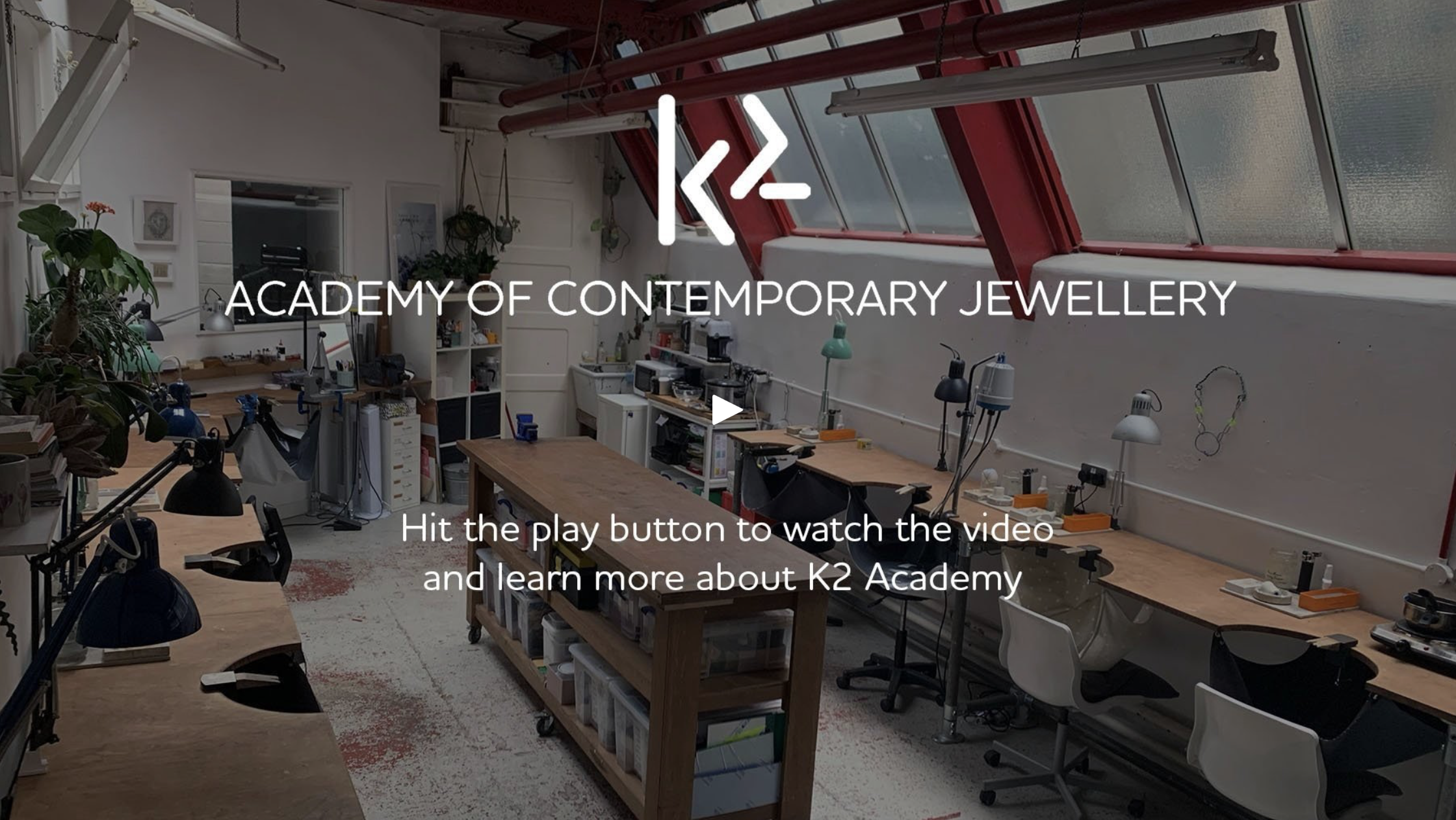Training at K2: Bridging the Experimental and the Practical
Article by Caroline Palmer
Design and craftsmanship are at the core of the K2 School of Contemporary Jewellery, which, in its eighth year, has nurtured more than 300 students through its studio. That studio is itself located in a 19th century industrial unit that Cockpit calls home, with its utilitarian architecture that resonates with that Bauhaus philosophy.
Meet Katrin Spranger and Kelvin J Birk, the founding directors and course leaders of K2.
The Origins of the K2 Academy of Contemporary Jewellery
There is a growing movement in the UK to return to crafts and craftsmanship the status and importance they once enjoyed. Events such as the recent London Craft Week, where workshops, independent makers, heritage craftspeople, artists and designers all open their doors each Spring, is just one way this is being achieved.
One of its most significant participants is Cockpit Arts, which has a base in Bloomsbury, London, and is home to some of the most skilled makers in the country. Among their number are two artist-makers who have made it their mission to be part of this revival by setting up a school of contemporary jewellery.
The school, founded by Katrin Spranger and Kelvin Birk in 2017, is breaking down barriers between the visual and decorative arts and craftsmanship by bridging the divide between the creative training of British art schools and the technical training traditions rooted in the UK’s jewellery sector.
It is no accident that both jewellers trained as goldsmiths in their home country of Germany, where the traditions of the Bauhaus — the design school of the 1920s that pushed back against industrialisation and put craftsmanship at its heart — are still influential.
Perspectives on Art and Design Education
Katrin and Kelvin would describe themselves as artist-jewellers and this is crucial to the way they have set up the school and in their style of teaching. It puts them squarely in the world of contemporary jewellery, with its vast array of styles from the fine to the highly experimental. But importantly it has a conceptual and handmade focus at its heart.
The contemporary jewellery world is vibrant, exciting and thriving, but it is fragile too, particularly in the UK. Design education in Britain, including jewellery design, has been subject to a decade of cuts to budgets and courses. This matters in part because art and design education is part of a complex ecosystem within which artists and makers support themselves as well as share their skills.
Yet for Kelvin and Katrin teaching has always been more than just a means to support their own making. They both run successful practices but also felt a vocation for teaching early on in their careers.
“I can’t imaging myself working as a full-time artist, and I cannot imaging myself working as a full-time teacher, either. I teach two-and-a-half days a week and it is the right mix of the two coming together for me. The two stimulate each other, it is very rewarding.”
The founders have very different, strong contrasting styles in their work. They both embrace the experimental, but while Kelvin’s jewellery is a vibrant, sometimes playful subversion of fine jewellery, often in yellow gold and exquisitely colourful precious stones, sometimes smashed into sparkling grounds, Katrin’s work, which also includes sculpture, visual and performance art, is powerful and monochrome, with a dark, sensual aesthetic. Their teaching styles are different too, but complementary.
Take a peek inside the classroom, a bright and dynamic studio space brought to life by the creativity of its students and teachers.
Diversity of Expression
The Cockpit Studios’ biannual Open Studios is a tribute to the founders’ approaches to teaching. Seeing the display of work from students of the school, the wide variety of styles is striking. Making is an act of individual expression, and it is obvious that the students have been afforded the space and support to develop their individual voices. This is helped by the fact that class sizes are small — around 10 students.
The mix of students at K2 is also notable — not just that they come from a wide range of backgrounds but age groups, too.
“I really love teaching people from different ages and backgrounds. It’s very stimulating in the classroom, and the discussions that this can lead to. The conversations we have are really, really interesting. And it is stimulating in your own work too.”
The school offers a wide variety of courses: from short evening and weekend courses for different levels of skills, to specialist short courses in wax carving, stone-setting or electroforming, for example. There is a one-year part-time diploma course for beginners and a jewellery diploma for intermediate students, which can be completed full-time in one year, or part-time over two years.
Enrolment opening soon!
The enrolment for our Diploma Courses starting in September 2025 is opening soon. Click the button below to find our more about our programs.
Creative and Technical Excellence
Kelvin and Katrin are proud of the standards that their students have achieved. A recent graduate of the advanced diploma course has won a place on the MA course at Alchimia, the contemporary jewellery school in Florence, Italy; another graduate is going on to Bishopsland, in Oxfordshire, UK. Other students have gone on to work for established jewellers and achieve representation at prestigious outlets.
The current crop of students, in common with past cohorts, are there for different reasons. Some want to use K2 as a stepping stone to further studies, some to set up their own jewellery businesses, others to work in the industry for other jewellers, and some to explore their creativity and stay open as to where this may lead. Whatever the ultimate goal there can be an underlying tension within the creative process of pursuing the practical outcomes and being experimental.
Lung jewellery made by former K2 student Kalsy Tang
Body piece made by former K2 student Michaela Barochova
Yet both Kelvin and Katrin agree that these two aims are not mutually exclusive, both have value and feed into each other, and in reality jewellers will often swing between these two aspects of making, with each enriching the other. It is for this reason that experimental work, often exploring non-precious materials, is encouraged.
“In my own practice there can be a tension between wanting creative freedom and pushing more towards the commercial work and then feeling really exhausted or very limited by it. The thing is not to worry about it. I think you go through these different stages.”
Kelvin agrees and emphasises the importance of being pushed to experiment and to be creative within the K2 courses, alongside learning the necessary technical skills. He also stresses the value of a good design education, which he feels is not valued enough within mainstream education.
Looking to the Future
The K2 founders are happy with the way the school has developed but still have ambitions. Katrin says she still harbours a dream “to run a more comprehensive course like a bachelor or even postgraduate degree, even both”. This reflects her love of the academic world — she was in full-time education for 10 years, including completing an MA in Stockholm, Sweden.
That vision of a fully comprehensive, immersive training is also something that Kelvin values.
“When I look back to my education in Germany, you were in the workshop three days a week, then you had drawing sessions, then you had gemmology. It’s like the Bauhaus approach. That, for me, would be the ideal college scenario.”
Caroline Palmer is a freelance journalist and editor based in London. She has worked for many UK newspapers and magazines, including the Financial Times, the Guardian, the Observer, the New Statesman, and the Independent, covering a range of subjects that span jewelry, business, politics, and design.







